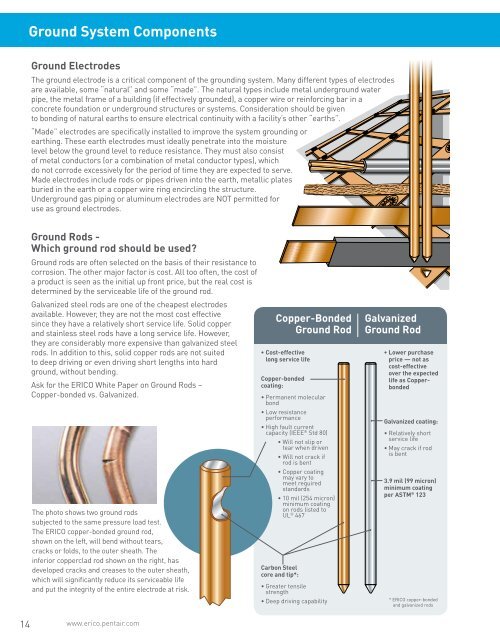GROUNDING BONDING AND ERICO CADWELD
H02th560
H02th560
Create successful ePaper yourself
Turn your PDF publications into a flip-book with our unique Google optimized e-Paper software.
Ground System Components<br />
Ground Electrodes<br />
The ground electrode is a critical component of the grounding system. Many different types of electrodes<br />
are available, some “natural” and some “made”. The natural types include metal underground water<br />
pipe, the metal frame of a building (if effectively grounded), a copper wire or reinforcing bar in a<br />
concrete foundation or underground structures or systems. Consideration should be given<br />
to bonding of natural earths to ensure electrical continuity with a facility’s other “earths”.<br />
“Made” electrodes are specifically installed to improve the system grounding or<br />
earthing. These earth electrodes must ideally penetrate into the moisture<br />
level below the ground level to reduce resistance. They must also consist<br />
of metal conductors (or a combination of metal conductor types), which<br />
do not corrode excessively for the period of time they are expected to serve.<br />
Made electrodes include rods or pipes driven into the earth, metallic plates<br />
buried in the earth or a copper wire ring encircling the structure.<br />
Underground gas piping or aluminum electrodes are NOT permitted for<br />
use as ground electrodes.<br />
Ground Rods -<br />
Which ground rod should be used?<br />
Ground rods are often selected on the basis of their resistance to<br />
corrosion. The other major factor is cost. All too often, the cost of<br />
a product is seen as the initial up front price, but the real cost is<br />
determined by the serviceable life of the ground rod.<br />
Galvanized steel rods are one of the cheapest electrodes<br />
available. However, they are not the most cost effective<br />
since they have a relatively short service life. Solid copper<br />
and stainless steel rods have a long service life. However,<br />
they are considerably more expensive than galvanized steel<br />
rods. In addition to this, solid copper rods are not suited<br />
to deep driving or even driving short lengths into hard<br />
ground, without bending.<br />
Ask for the <strong>ERICO</strong> White Paper on Ground Rods –<br />
Copper-bonded vs. Galvanized.<br />
The photo shows two ground rods<br />
subjected to the same pressure load test.<br />
The <strong>ERICO</strong> copper-bonded ground rod,<br />
shown on the left, will bend without tears,<br />
cracks or folds, to the outer sheath. The<br />
inferior copperclad rod shown on the right, has<br />
developed cracks and creases to the outer sheath,<br />
which will significantly reduce its serviceable life<br />
and put the integrity of the entire electrode at risk.<br />
Copper-Bonded<br />
Ground Rod<br />
• Cost-effective<br />
long service life<br />
Copper-bonded<br />
coating:<br />
• Permanent molecular<br />
bond<br />
• Low resistance<br />
performance<br />
• High fault current<br />
capacity (IEEE ® Std 80)<br />
• Will not slip or<br />
tear when driven<br />
• Will not crack if<br />
rod is bent<br />
• Copper coating<br />
may vary to<br />
meet required<br />
standards<br />
• 10 mil (254 micron)<br />
minimum coating<br />
on rods listed to<br />
UL ® 467<br />
Carbon Steel<br />
core and tip*:<br />
• Greater tensile<br />
strength<br />
• Deep driving capability<br />
Galvanized<br />
Ground Rod<br />
• Lower purchase<br />
price — not as<br />
cost-effective<br />
over the expected<br />
life as Copperbonded<br />
Galvanized coating:<br />
• Relatively short<br />
service life<br />
• May crack if rod<br />
is bent<br />
3.9 mil (99 micron)<br />
minimum coating<br />
per ASTM ® 123<br />
* <strong>ERICO</strong> copper-bonded<br />
and galvanized rods<br />
14 www.erico.pentair.com


